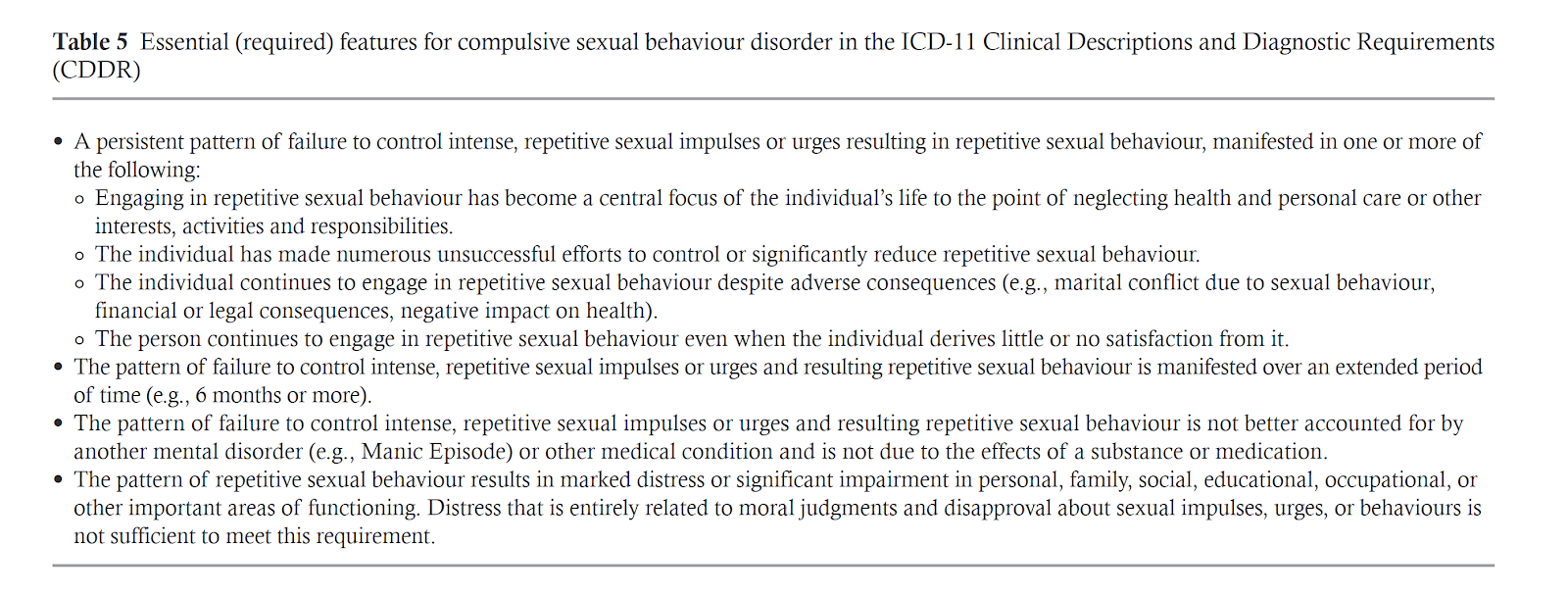What is Compulsive Sexual Behavior Disorder?

After years in this field, those of us who treat problematic or compulsive sexual behavior still hear from colleagues that they do not believe that sex addiction is real.
Worse yet, those of us who treat it have been accused of simply being in it for the money. I have a good laugh at that one.
However, one of the arguments that some opposed to the concept of sexual addiction make is that a loose diagnosis of the problem can be confounded by religious or personal beliefs.
Moral Incongruence
This has spurred some great research by Perry, Grubbs and others about moral incongruence, whose basic premise is that some people’s distress over their sexual behavior, which they often label pornography addiction, is caused by them sexually acting in a manner that is against either their religious or personal values. Many of these individuals seek treatment for their self-diagnosed addiction.

Are you a Licensed Professional Counselor in need of continuing education? Learn more about Sex Addiction, Erotic Conflict, and Moral Incongruence from Dr. Weeks and Sexual Addiction Treatment Services, an NBCC ACEP™ approved provider!
Sexual Addiction Treatment Services has been approved by NBCC as an Approved Continuing Education Provider, ACEP No. 7250. Programs that do not qualify for NBCC credit are clearly identified. Sexual Addiction Treatment Services is solely responsible for all aspects of the programs.
Enter, the World Health Organization
Compulsive Sexual Behavior Disorder (CSBD) is not a name or diagnosis that has made its way into the internet lexicon like sex addiction or pornography addiction. It is, however, the World Health Organization’s recently (2019) approved diagnosis in the International Classification of Diseases-11 (ICD-11) relating to what is commonly referred to as sexual addiction. Reporting on the new system went into effect January 1 of this year.
As a side note, the DSM-V does not recognize sexual addiction or pornography addiction as a valid mental health disorder.

Are you a professional looking to stay up-to-date with the latest information on, sex addiction, trauma, and mental health news and research? Or maybe you’re looking for continuing education courses?
Stay up-to-date with all of Dr. Jen’s work through her practice’s newsletter!

Removing Ambiguity about Compulsive Sexual Behavior
One of the most exciting things about the diagnostic criteria for CSBD is that it removes the confound of moral incongruence from the diagnostic picture. The diagnostic criteria specifically states that any distress that is: “entirely related to moral judgments and disapproval about sexual impulses, urges, or behaviors is not sufficient to meet the requirement of marked distress. If one looks closely, the diagnostic criteria are strictly behavioral, removing the feelings of the actor or any family member of the actor from the picture.”
Why does this make a difference?
Well, for several reasons:
- This is global recognition that CSBD is a real and valid issue that many people struggle with.
- It allows for a more nuanced diagnosis that can help clinicians provide treatment best suited for their clients.
The treatment paradigm for someone dealing with sexual behavior with moral incongruence is not necessarily the same treatment plan for someone with CSBD.
Concerned that you may be dealing with CSBD? The CSBD-19 is a validated self-report assessment you can take to help you understand your behavior.
Want to take the CSBD-19 right here in your browser with results you can share with your therapist? We’ve made that available for you for free!


Are you looking for more reputable data-backed information on sexual addiction? The Mitigation Aide Research Archive is an excellent source for executive summaries of research studies.
Have you found yourself in legal trouble due to your sexual behavior? Seek assistance before the court mandates it, with Sexual Addiction Treatment Services.


Do you feel your sexual behavior, or that of someone you love, is out of control? Consult with a professional.
